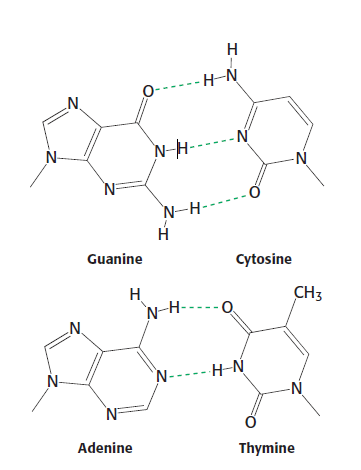Watson-Crick base pairs: Difference between revisions
Jump to navigation
Jump to search
m Moved the full stop to come after the reference. |
mNo edit summary |
||
| Line 1: | Line 1: | ||
[[Image:Watson-Crick Base Pairs.PNG|left|Watson-Crick Base Pairs.PNG]]<ref>Berg, J, Stryer,L ,Tymoczko J,2012, Biochemistry, 7th edition. W. H. Freeman and Company, New York. Pg. 114, Figure 4.12.</ref> Watson-Crick base pairs is a specific complementary base pairs that base A is always paired with base T while base G is always paired with base C. <span style="line-height: 1.5em;">These base pairs were introduced by </span>[[James Watson|James Watson]]<span style="line-height: 1.5em;"> and </span>[[Francis Crick|Francis Crick]]<span style="line-height: 1.5em;">. In Watson-Crick base pairs, t</span><span style="line-height: 1.5em;">he number of </span>[[Hydrogen bonds|hydrogen bonds]]<span style="line-height: 1.5em;"> formed between A and T are 2 while there are 3 formed between base G and C | [[Image:Watson-Crick Base Pairs.PNG|left|Watson-Crick Base Pairs.PNG]]<ref>Berg, J, Stryer,L ,Tymoczko J,2012, Biochemistry, 7th edition. W. H. Freeman and Company, New York. Pg. 114, Figure 4.12.</ref> Watson-Crick base pairs is a specific complementary base pairs that base A is always paired with base T while base G is always paired with base C. <span style="line-height: 1.5em;">These base pairs were introduced by </span>[[James Watson|James Watson]]<span style="line-height: 1.5em;"> and </span>[[Francis Crick|Francis Crick]]<span style="line-height: 1.5em;">. In Watson-Crick base pairs, t</span><span style="line-height: 1.5em;">he number of </span>[[Hydrogen bonds|hydrogen bonds]]<span style="line-height: 1.5em;"> formed between A and T are 2 while there are 3 formed between base G and C <ref>Berg, J, Stryer,L ,Tymoczko J,2012, Biochemistry, 7th edition. W. H. Freeman and Company, New York. Pg. 114</ref>. [[Cytosine|Cytosine]] and [[Thymine|Thymine]] are pyrimidine compounds and [[Guanine|Guanine]] and [[Adenine|Adenine]] are purine compounds. The purine compunds are larger than the pyrimidines as the 6-membered ring has an extra 5-membered ring fused to it <ref>Alberts et al. Molecular biology of the cell, fifth edition, 2007. Page 61</ref>. </span> | ||
=== References === | === References === | ||
<references /> | <references /> | ||
Revision as of 13:58, 22 October 2018

[1] Watson-Crick base pairs is a specific complementary base pairs that base A is always paired with base T while base G is always paired with base C. These base pairs were introduced by James Watson and Francis Crick. In Watson-Crick base pairs, the number of hydrogen bonds formed between A and T are 2 while there are 3 formed between base G and C [2]. Cytosine and Thymine are pyrimidine compounds and Guanine and Adenine are purine compounds. The purine compunds are larger than the pyrimidines as the 6-membered ring has an extra 5-membered ring fused to it [3].
References
- ↑ Berg, J, Stryer,L ,Tymoczko J,2012, Biochemistry, 7th edition. W. H. Freeman and Company, New York. Pg. 114, Figure 4.12.
- ↑ Berg, J, Stryer,L ,Tymoczko J,2012, Biochemistry, 7th edition. W. H. Freeman and Company, New York. Pg. 114
- ↑ Alberts et al. Molecular biology of the cell, fifth edition, 2007. Page 61